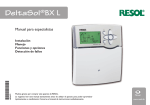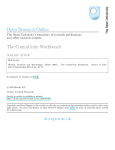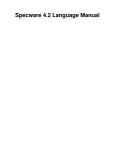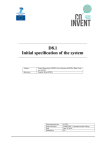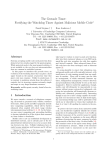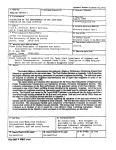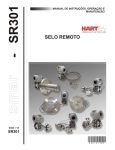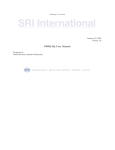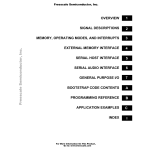Download THE USER'S GUIDE FOR THE AUTHORS
Transcript
THE PUBLISHING HOUSE OF THE ROMANIAN ACADEMY PROCEEDINGS OF THE ROMANIAN ACADEMY, Series A, Volume 7, Number 1/2006, pp. 000-000 RDF FRAMEWORK INSTITUTIONS Dorel LUCANU*, Yuan Fang LI**, Jin Song DONG** * Faculty of Computer Science, “Alexandru Ioan Cuza” University, Romania ** School of Computing, National University of Singapore, Singapore Corresponding author: Dorel Lucanu: [email protected] The Semantic Web is a vision of enabling software agents to autonomously understand, process and integrate Web resources. This ability is based on semantically marking up Web resources using ontologies. Ontology languages are based on Resource Description Framework (RDF) and RDF Schema (RDFS), which form the foundation of the Semantic Web. In this paper, we define the RDF framework in terms of institution theory and investigate the exactness property. Key words: Semantic Web, RDF, RDF Schema, institution. 1. INTRODUCTION The Semantic Web [2] has attracted much attention as a new generation of the current World Wide Web. It attempts to realize the full potential of the Web by semantically marking up Web resources so that they can be readily processed by software agents on the Web. Ontologies provide such markups for the Semantic Web. As depicted in Fig. 1, the development of Semantic Web languages takes a layered approach, in which languages higher in the stack are developed based on those below them. The Resource Description Framework (RDF) [9] and RDF Schema (RDFS) [3] are the cornerstone languages of the Semantic Web. They define the set of basic vocabularies and syntax for later ontology languages. Directly sitting on RDF and RDFS, ontology languages such as DAML+OIL [15], OWL [11] and the Horn-style rules extension SWRL [10] have been developed to improve the expressivity of the Semantic Web. These languages extend the expressivity of RDF and RDFS by defining more language constructs to further classify and relate Web resources. The Web Ontology language (OWL) is the mainstream ontology language. It has three increasingly expressive sub languages: OWL Lite, DL and Full. By imposing certain restrictions on the use of RDF, RDFS and OWL Full constructs, OWL Lite and DL are decidable. Recently, researchers have observed some issues related to the layering of OWL languages on top of RDFS [5]. It has been argued by some researchers that the layering of OWL Lite and DL on top of RDFS is not very proper as they redefine the semantics of some of the RDFS vocabularies [5, 14]. Such improper layering may cause interoperability problems between ontologies written in these languages. Hence, it is of fundamental importance to thoroughly study the properties of RDF and RDFS to provide more insight into investigating the layering issue. The notion of institutions [7] was proposed to formalize the concepts of logical systems. Institutions provide a means of reasoning about software specifications regardless of the logical system. Hence, it serves as a natural candidate to study the relationship among the various SW languages, as they are based on different logical systems (semantics). Institution (co)morphisms [8] capture the migration from one logical system to another. The rest of the paper is organized as follows. In Section 2, we briefly present the background information on the Semantic Web, the RDF and RDFS languages, institution and institution morphisms. In ___________________________________________________________ Recommended by Mihai DRÂGÂNESCU, member of the Romanian Academy Dorel LUCANU, Yuan FANG LI, Jin SONG DONG 2 Section 3, we present three institutions. The first one is for the bare RDF, which is a bare bone RDF we constructed that only includes the triple format and resource references. Building on the institution of bare RDF, we then develop the institution for the actual RDF, including its vocabularies and defining their semantics. Thirdly, we construct the institution for RDFS by defining semantics for its language constructs. The exactness properties of these institutions are discussed. Finally, Section 4 concludes the paper and discusses future works. 2. PRELIMINARIES 2.1 RDF FRAMEWORK The Semantic Web is a vision as the new generation of the current Web in which information is semantically marked-up so that intelligent software agents can autonomously understand, process and aggregate data. This ability is realized through the development of a “stack” of languages, as depicted by Berners-Lee in Fig. 1. Figure 1 Based on mature technologies such as XML, Unicode and URI (Uniform Resource Identifier), The Resource Description Framework (RDF) [9] is the foundation of later languages in the SW. RDF is a model of metadata defining a mechanism for describing resources that makes no assumptions about a particular application domain. It allows structured and semi-structured data to be mixed and shared across applications. It provides a simple way to make statements about Web resources. An RDF document is a collection of triples, statements of the form 〈subject predicate object〉, where subject is the resource we are interested in, predicate specifies the property or characteristic of the subject and object states the value of the property. RDF also defines vocabularies for constructing containers such bag, sequence, list, etc. RDF Schema [3] provides additional vocabularies for describing RDF documents. It defines semantical entities such as resource, class, property, literal and various properties about these entities, such as subClassOf, domain, range, etc. In RDF Schema, resource is the universe of description. It can be further categorized as class, property, datatype or literal. With these semantical constructs, RDF Schema can be regarded as the basic ontology language. 2.2 INSTITUTIONS Institutions supply a uniform way for structuring the theories in various logical systems. Many logical systems have been proved to be institutions. Recent research showed that institutions are useful in designing tools supporting verification over multiple logics. The basic reference for institutions is [7]. A well structured approach of the various institution morphisms and many other recent constructions can be found in [8]. A recent application of institutions in formalizing the information integration is given in [6]. The institutions use intensively category theory; we recommend [1] for a detailed presentation of categories and their applications in computer science. An institution is a quadruple ℑ = ( Sig , Mod , Sen,|=) , where Sig is 3 RDF framework institutions a category whose objects are called signatures, Mod : Sig op → Cat is a functor which associates with each signature Σ a category whose objects are called Σ -models, Sen is a functor Sen : Sig → Set which associates with each signature Σ a set whose elements are called Σ -sentences, and |= is a function which associates with each signature Σ a binary relation |=Σ ⊆ Mod (Σ) × Sen(Σ) , called satisfaction relation, such that for each signature morphism φ : Σ → Σ ' the satisfaction condition Mod (φ op )( M ') |= Σ ϕ ⇔ M ' |= Σ ' Sen(φ )(ϕ ) holds for each model M ' ∈ Mod (Σ ') and each sentence ϕ ∈ Sen(Σ) . The functor Mod is defined over the opposite category Sig op because a ``translation between vocabularies'' φ : Σ → Σ ' defines a forgetful functor Mod (φ op ) : Mod (Σ ') → Mod (Σ) such that for each Σ ' -model M ' , Mod (φ op )( M ') is M ' viewed as a Σ -model and it is called the reduct of M ' along φ . The functor Sen abstracts the way the sentences are constructed from signatures (vocabularies). The satisfaction condition may be read as “ M ' satisfies the φ translation of ϕ iff M ' , viewed as a Σ -model, satisfies ϕ ”, i.e., the meaning of ϕ is not changed by the translation φ . A specification (presentation) is a way to represent the properties of a system independent of model (= implementation). Formally, a specification is a pair (Σ, F ) , where Σ is a signature and F is a set of Σ sentences. A (Σ, F ) -model is a Σ -model M such that M |= Σ φ for each ϕ ∈ F . A theory is a specification (Σ, F ) with F closed, i.e., satisfying the property (∀ϕ a Σ-sentence) [(∀M a (Σ, F )-model) M |= Σ ϕ ] ⇒ ϕ ∈ F . A signature morphism φ : Σ → Σ ' is a theory morphism φ : (Σ, F ) → (Σ ', F ') iff for each Σ sentence ϕ , we have ϕ ∈ F ⇒ φ (ϕ ) ∈ F ' . We denote by Th the category of theories. Given an institution, the theoroidal institution ℑth of ℑ is the institution I th = (Th, Mod th , Sen th ,|=th ) , where Mod th is the extension of Mod to theories, Senth is sign; Sen with sign : Th → Sig the functor which forgets the sentences of a theory, and |=th = sign ;|= . An important property of the logical systems is that the finite limits are preserved by the model functor. This property is called in literature exactness. We recall that the functor Mod is defined over Sig op and the limits in this category are in fact colimits in Sig . If the model functor preserves only the pullbacks, then the institution is semiexact. Let ℑ = ( Sig , Mod , Sen,|=) and ℑ ' = ( Sig ', Mod ', Sen ',|= ') be two institutions. An institution morphism (Φ , β , α ) : ℑ → ℑ ' consists of: 1. a functor Φ : Sig → Sig ' , β : Mod ⇒ Φ op ; Mod ' , βΣ : Mod (Σ) → Mod (Φ (Σ)) , and 3. a natural transformation α : Φ; Sen ' ⇒ Sen , α Σ : Sen '(Φ (Σ)) → Sen(Σ) , 2. a natural transformation such that the following satisfaction condition holds: M |= Σ α Σ (ϕ ') ⇔ β Σ ( M ) |=,Φ ( Σ ) ϕ ' i.e., a natural family of functors i.e., a natural family of functions Dorel LUCANU, Yuan FANG LI, Jin SONG DONG 4 for any Σ -model M in ℑ and Φ(Σ) -sentence ϕ ' in ℑ ' . Usually, the institution morphisms are used to express the embedding relationship. An example of institution morphism is (Φ, β , α ) : ℑth → ℑ which express the embedding of ℑ in ℑth . We show how a theory (Σ 0 , F0 ) and a semantical constraint can define an institution ℑ(Σ o , F0 ) . A semantical constraint is a map ! _ "c which associates a subcategory !(Σ, F )"c ⊆ Mod th (Σ, F ) with each theory (Σ, F ) , such that Mod (φ )( M ') ∈ !(Σ, F )"c for all φ : (Σ, F ) → (Σ ', F ') and M ' ∈ ! (Σ ', F ')"c . The constraints defined in [7] are a particular case of semantical constraints defined here when the subcategory can be syntactically represented. The institution ℑ(Σ o , F0 ) is defined as follows: 1. the category of signatures is the comma category (Σ 0 , F0 ) ↓ Th , where the objects are theory morphisms f : (Σ 0 , F0 ) → (Σ, F ) , and the arrows φ : f → f ' are consisting of theory morphisms φ : (Σ, F ) → (Σ ', F ') such that f ; φ = f ' , 2. the model functor Mod (ℑ(Σ 0 , F0 )) maps each signature f : (Σ 0 , F0 ) → (Σ, F ) into the subcategory !(Σ, F )"c , 3. the sentence functor Sen(ℑ(Σ 0 , F0 )) maps a signature f : (Σ 0 , F0 ) → (Σ, F ) into the set of Σ sentences, 4. the satisfaction relation is defined by M |= f ϕ iff M |= Σ ϕ . Note that the semantical constraint is required only for the theories (Σ, F ) for that there exists a theory morphism f : (Σ 0 , F0 ) → (Σ, F ) . If φ : (Σ 0 , F0 ) → (Σ 0' , F0' ) is a theory morphism, then there is an institution morphism (Φ , β , α ) : ℑ(Σ 0' , F0' ) → ℑ(Σ 0 , F0 ) . 3. INSTITUTION OF RDF FRAMEWORK In this section, we define the institutions for the languages RDF and RDF Schema. The construction of these institutions is divided into three parts. Firstly, we construct a bare-bone institution for RDF logic, capturing only the very essential concepts in RDF, namely the resource references and the triples format. This logic then serves as the basis on which the institutions of the actual RDF and RDF Schema are constructed. 3.1 BARE RDF INSTITUTION The Bare RDF institution BRDF is a bare-bone institution with resource references sets as the only signatures and triples as sentences. We use it as a basis over which we develop the other institutions involved in Semantic Web. A signature RR in BRDF is a set of resource references. A signature morphism φ : RR → RR ' is an arrow in Set . The RR -sentences are triples of the form ( sn, pn, on) , where sn, pn, on ∈ RR . Usually, sn is for subject name, pn is for property (predicate) name, and on is for object name. RR -models I are tuples I = ( RI , PI , S I , ext I ) , where RI is a set of resources, PI is a subset of RI - the set of properties, S I : RR → RI is a function that maps each resource reference to some resource, and extI : PI →℘( RI × RI ) is an extension function mapping each property to a set of pairs of resources that it relates. An RR -homomorphism h : I → I ' between two RR -models is a function h : RI → RI ' such that h( PI ) ⊆ h( PI ' ) , S I ; h = S I ' , and ext I ;(h × h) = extI ' . If φ : RR → RR ' is a signature morphism and I ' 5 RDF framework institutions an RR ' -model, then the reduct of I ' along φ is the RR -model I defined as follows: RI = RI ' , PI = PI ' , S I = S I '|RR , extI = ext I ' . The satisfaction is defined as follows: I |= RR ( sn, pn, on) iff ( S I ( sn), S I (on)) ∈ ext I ( S I ( pn)) , that ( sn, pn, on) is satisfied if and only if the pair consisting of the resources associated with the subject name sn and the object name on is in the extension of pn . Since the signatures in BRDF are sets, it follows that both the category of signatures and category of theories are cocomplete. Theorem 1. BRDF is not exact. Proof. Let {RR1 , RR2 } be a discrete diagram and (ψ 1 : RR → RR1 ,ψ 2 : RR → RR2 ) its limit in Set op . If I j is a RR j -model, j = 1, 2 , such that RI1 ≠ RI2 , then there is no an RR -model I with Mod (ψ j )( I ) = I j , j = 1, 2 . Theorem 2. BRDF is semiexact. Proof. Let (ψ 1 : RR → RR1 ,ψ 2 : RR → RR2 ) be the pullback of the following diagram in Set op φ1 : RR1 → RR0 ← RR2 : φ2 . If I j is a RR j -model, j = 1, 2 , such that Mod (φ1 )( I1 ) = Mod (φ2 )( I 2 ) then RI1 = RI2 . We can define an RR -model I with Mod (ψ j )( I ) = I j , j = 1, 2 . We set RI = RI1 , PI = PI1 ∪ PI2 , S I (rr ) = S I j (rr ) if rr ∈ RR j , and ext I ( p) = extI j ( p) if p ∈ Pj , j = 1, 2 . Corollary. BRDFth is semiexact. 3.2 RDF INSTITUTION The RDF institution ℑ(RDF) is defined using the construction we defined in Section 2 starting from a theory RDF and a semantical constraint ! _ "RDF . RDF theory is RDF = (VRDF ,TRDF ) , where the RDF vocabulary VRDF includes the following items: rdf:type, rdf:Property, rdf:value, rdf:Statement, rdf:subject, rdf:predicate, rdf:object, rdf:List, rdf:first, rdf:rest, rdf:nil, rdf:Seq, rdf:Bag, rdf:Alt, rdf:_1 rdf:_2 ... and TRDF includes the following triples: (rdf:type,rdf:type,rdf:Property), (rdf:first,rdf:type,rdf:Property), (rdf:subject,rdf:type,rdf:Property), (rdf:rest,rdf:type,rdf:Property), (rdf:predicate,rdf:type,rdf:Property) (rdf:nil,rdf:type,rdf:List), , (rdf:_1,rdf:type,rdf:Property), (rdf:object,rdf:type,rdf:Property), (rdf:_2,rdf:type,rdf:Property), (rdf:value,rdf:type,rdf:Property), ... We suppose that there is given a set RRDF of RDF resources and a function S RDF : VRDF → RRDF which associates a resource with each RDF symbol. It is easy to see that RRDF and S RDF can be extended to a RDF-model I RDF . For each theory such that there is theory morphism, we consider the semantical constraint !( RR, T )"RDF as consisting of those ( RR, T ) -models I such that: 1. RI includes RRDF , and the restriction of S I coincides with S RDF , Dorel LUCANU, Yuan FANG LI, Jin SONG DONG 6 2. if p ∈ PI then ( p, rdf:Property) ∈ ext I (rdf:type) Since f is theory morphism, the restriction of I to VRDF is an RDF-model. Example. The reification is given by the RDF signature reification : RDF → ({r , s, p, o}, T ) , where T further to TRDF includes the triples: (r , rdf:type, rdf:Statement), (r , rdf:subject, s ), (r , rdf:predicate, p ), (r , rdf:object, o ). We denote by ℑ(RDF) the institution defined by the theory RDF together with the semantical constraint ! _ "RDF using the method presented in Section 2. Proposition 1. There is an institution morphism ℑ(RDF) → BRDF . Theorem 3. ℑ(RDF) is exact. Proof. Any two RDF signatures f1 : RDF → ( RR1 , T1 ) and f 2 : RDF → ( RR2 , T2 ) have a pushout in Th(BRDF) and we apply Corollary of Theorem 2. 3.2 RDF SCHEMA INSTITUTION RDF Schema defines additional language constructs for the RDF language. It expands the expressivity of RDF by introducing the concept of universe of resources rdfs:Resource, the classification mechanism rdfs:Class, and a set of properties that relate them rdfs:subClassOf, rdfs:domain, rdfs:range. Hence, it is natural for the RDF Schema institution ℑ(RDFS) to be developed on top of ℑ(RDF) , with some more semantical constraints added to capture the semantics of RDF Schema language constructs. The RDF Schema theory RDFS = (VRDFS , TRDFS ) is composed of the RDF Schema vocabulary VRDFS including VRDF together with rdfs:domain, rdfs:range, rdfs:Resource, rdfs:Literal, rdfs:Datatype, rdfs:Class, rdfs:subClassOf, rdfs:subPropertyOf, rdfs:member, rdfs:Container, rdfs:ContainerMembershipProperty and the triples TRDFS including TRDF together with: (rdf:type, rdfs:domain, rdfs:Resource), (rdfs:domain, rdfs:domain, rdf:Property), (rdfs:range, rdfs:domain, rdf:Property), (rdfs:subPropertyOf, rdfs:domain, rdf:Property), (rdfs:subClassOf, rdfs:domain, rdfs:Class), (rdf:subject, rdfs:domain, rdf:Statement), (rdf:predicate, rdfs:domain, rdf:Statement), … Here we present only a part of triples added to TRDFS . The complete set of triples defining TRDFS can be found in [9]. As for RDF, we suppose that there is given a set RRDFS of RDF Schema resources and a 7 RDF framework institutions function S RDFS : VRDFS → RRDFS which associates a resource with each RDF symbol and that satisfies S RDFS |VRDF = S RDF . RRDFS and S RDFS can be extended to a RDFS-model I RDFS . For each theory such that there is a theory morphism f : RDFS → ( RR, T ) , we consider the semantical constraint !( RR, T )"RDFS as consisting of those ( RR, T ) -models I such that: 1. RI includes RRDFS , and the restriction of S I coincides with S RDFS , 2. ext I (rdfs:Resource) = RI 3. (∀x, y, u , v ∈ RI )( x, y ) ∈ ext I (rdfs:domain) ∧ (u , v) ∈ extI ( x) ⇒ u ∈ extI ( y ) 4. (∀x, y, u , v ∈ RI )( x, y ) ∈ ext I (rdfs:range) ∧ (u, v) ∈ extI ( x) ⇒ v ∈ extI ( y ) 5. (∀x, y ∈ RI )( x, y ) ∈ extI (rdfs:subClassOf) ⇒ extI ( x) ⊆ extI ( y ) 6. (∀x ∈ ext I (rdfs:Class)( x, rdfs:Resource) ∈ ext I (rdfs:subClassOf) 7. (∀x, y ∈ RI )( x, y ) ∈ extI (rdfs:subPropertyOf) ⇒ extI ( x) ⊆ extI ( y ) 8. (∀x ∈ ext I (rdfs : ContainerMembershipProperty)) ( x, rdfs:member) ∈ ext I (rdfs:subPropertyOf) Proposition 2. There is an institution morphism ℑ(RDFS) → ℑ(RDF) . Proof. The institution morphism is given by the inclusion RDF → RDFS . Theorem 4. ℑ(RDFS) is exact. It is known that unsorted first-order logic is only semiexact. Hence the embedding of RDF Schema in first-order logic can be inappropriate for many software applications. In turn, the sorted first-order is exact and therefore is more appropriate to embed RDF Schema. 4. CONCLUSION RDF and RDF Schema define the basic vocabularies for describing Semantic Web resources. They are the foundation on which more expressive ontology languages are constructed. Institutions and institution morphisms are used to formally represent and reason about the migration of different logical systems. In this paper, we use institutions to represent languages RDF and RDF Schema and use institution morphisms to relate them. The exactness property of various RDF institutions is also discussed. One interesting conclusion we reached is that the institution for RDFS is exact. As unsorted first-order logic is known to be semiexact, the exactness of RDF Schema implies that there might be issues of applying some first-order logic reasoning tools to RDF Schema ontologies. As stated previously, the layering of the ontology language OWL on top of RDF Schema has been criticized to be improper, possible follow-up work would be to further investigate the layering issue. REFERENCES 1. 2. 3. 4. 5. BARR, M., WELLS, Ch., Category Theory for Computing Science, Les Publications CRM, Montreal, third edition, 1999. BERNERS-LEE, T., HENDLER, J., LASSILA, O., The Semantic Web, Scientific American, May 2001. BRICKLEY, D., GUHA, R.V., Description Framework (RDF) Schema Specification 1.0, http://www.w3.org/TR/rdf-schema/, February 2004. DIACONESCU, R., Grothendieck institutions, Applied Categorical Structures, 10, pp. 383--402, 2002. de BRUIJN, J., LARA, R., POLLERERS, A., FENSEL, D., OWL DL vs. OWL flight: conceptual modeling and reasoning the semantic Web, Proc. of the 14th International Conference on World Wide Web (WWW2005), Chiba, Japan, May 10-14, 2005, pp. 623--632. Dorel LUCANU, Yuan FANG LI, Jin SONG DONG 6. 7. 8. 9. 10. 11. 12. 13. 14. 15. 8 GOGUEN, J., Three Perspectives on Information Integration,Proc of Semantic Interoperability and Integration, Schloss Dagstuhl, Germany, 2005. GOGUEN, J., BURSTALL, R., Institutions: Abstract Model Theory for Specification and Programming, Journal of the Association for Computing Machinery, 39(1), pp.95--146, 1992. GOGUEN, J., ROŞU, G., Institution Morphism, Formal Aspects of Computing, 13, pages 274--307, 2002. HAYES P., RDF Semantics, http://www.w3.org/TR/rdf-mt/, February 2004. HORROCKS, I., PATEL-SCHNEIDER, P. F., BOLEY, H., TABET, S., GROSOF, B., DEAN, M., SWRL: A semantic web rule language combining OWL and RuleML, http://www.daml.org/2004/11/fol/rules-all.html, November 2004. HORROCKS, I., PATEL-SCHNEIDER, P. F., van HARMELEN, F., From SHIQ and RDF to OWL: The making of a web ontology language, Journal of Web Semantics, 1(1):7--26, 2003. KLYNE, G., CARROLL, J. (editors), Resource Description Framework (RDF): Concepts and Abstract Syntax, W3C Recommendation, http://www.w3.org/TR/rdf-concepts/, 2004. LUCANU, D., LI, Y.F., DONG, J.S., Web Ontology Verification and Analysis in the Z Framework, Technical Report TR 05-01, University ``Alexandru Ioan Cuza'' of Iaşi, Romania, January 2005, http://thor.info.uaic.ro/~tr/tr05-01.ps. PATEL-SCHNEIDER, P. F., HAYES, P., HORROCKS, I. (editors), OWL Web Ontology Semantics and Abstract Syntax, http://www.w3.org/TR/2004/REC-owl-semantics-20040210/, 2004. van HARMELEN, F., PATEL-SCHNEIDER, P. F., HORROCKS, I. (editors), Reference description of the DAML+OIL ontology markup language, http://www.daml.org/2001/03/reference.html, March, 2001. Received October 17, 2005









